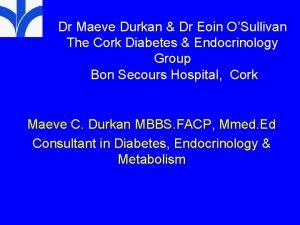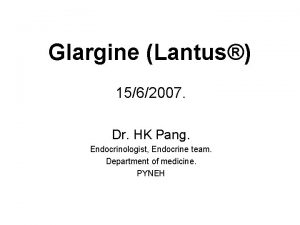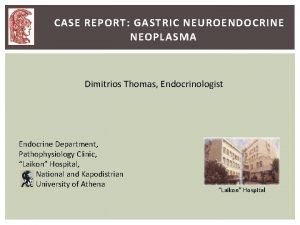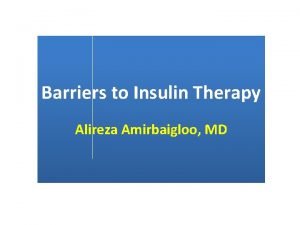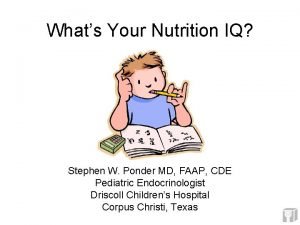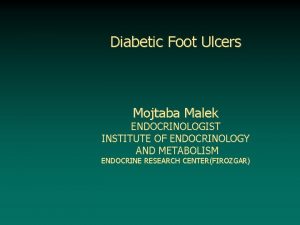H Delshad M D Endocrinologist Research Institute for


















































- Slides: 50


H. Delshad M. D Endocrinologist Research Institute for Endocrine Sciences

Case Discussion A 64 -year-old man was diagnosed with type 2 diabetes 9 years ago, which is currently being treated with: Metformin (1000 mg twice daily) Gliclazide (160 mg twice daily) Sitagliptin (100 mg once daily) He is overweight, with a BMI of 29 kg/m 2 He does not have any diabetic complications. He has hypertension, which is being treated with 10 mg Lisinopril once daily, and dyslipidemia , which is being treated with 5 mg Rosuvastatin once daily. He has no history of cardiovascular disease or hypoglycemia.

SMBG 6 2 4 1 3 5 7

According to the latest recommendations from the ADA / EASD , what is the most appropriate Hb. A 1 c target for this patient? ABCD- ≤ 7. 5 ≤ 7. 0% ≤ 6. 5% ≤ 6. 0%

You tell him that you would like to intensify his anti-hyperglycemic treatment so that he can reduce his Hb. A 1 c to the target. He does not think his current Hb. A 1 c level of 7. 8% is particularly high, so he doesn't see the need for a lower target.

What is the most appropriate reply to him? A- Agree to an Hb. A 1 c target of 7. 0% rather than ≤ 6. 5% over the next 3 months B- Agree to focus initially on reducing his blood pressure and body weight and delay intensification therapy for 3 months later. C- Tell him that his Hb. A 1 c needs to be reduced as soon as possible in order to minimize the risk for microvascular and macrovascular complications associated with T 2 D D- Agree to maintain his current treatment regimen for the time being and review his Hb. A 1 c, blood pressure, and body weight in 3 months.

What is the most appropriate intensification regimen for the patient at this stage? abcd- A once-daily basal insulin regimen A once-daily premix insulin regimen A twice-daily premix insulin regimen A once-daily GLP 1 agonist regimen

Specific Goals in Management of Diabetes • Fasting plasma glucose = 80 -130 mg/d. L • Post-meal plasma glucose < 180 mg/d. L • A 1 C < 7% • Blood Pressure < 130 -140/80 – 90 mm. Hg • LDL < 100 mg/d. L; HDL > 45 -50 mg/d. L • Triglycerides < 150 mg/d. L

Relative Risk of Progression of Diabetes Complications (DCCT) Mean A 1 C DCCT Research Group, N Engl J Med 1993, 329: 977 -986.

Effect of A 1 C On Complications in the UKPDS Study %60 A 1 C 50 5. 5% 40 6. 5% 7. 5% 8. 5% 9. 5% 10. 5% 30 20 10 0 Hb. A 1 C Myocardial Infarction Microvasc Disease

Risk of complications Correlation between a 1% A 1 C decrease and reduced risk of complication 21% 43% 14% 37% Cardiovascular complications Amputations or death Microvascular from peripheral complications vascular disease (p < 0. 0001) Diabetes-related death Myocardial infarction All-cause mortality (p < 0. 0001) Stratton IM, et al. BMJ. 2000: 321: 405 -412.

Uncontrolled hyperglycaemia is a global problem Proportion of patients achieving target Hb. A 1 c (%) Prevalence data 80 Hb. A 1 c <7. 5% 67 60 Hb. A 1 c ≤ 7. 0%* 51 40 Hb. A 1 c <7. 0%* 37 20 0 CHINA (CODIC-2)1 CANADA (DICE)2 USA (NHANES)3 Hb. A 1 c ≤ 6. 5%* 31 EUROPE (CODE-2)4 *National guidelines target Hb. A 1 c 1 Chen Xingbao, Chinese Health Economics 2003; Tang Ling, China Diabetic Journal 2003; 2 Harris 4 Liebl SB, et al. Diabetes Res Clin Pract 2005; 70: 90– 7; 3 Saydah SH, et al. JAMA 2004; 291: 335– 42; A, et al. Diabetologia 2002; 45: S 23– 8


Diabetes is a progressive condition Beta-cell function continues to decline 100 Clinical Diagnosis 75 -Cell Function (%) 50 25 0 Onset of Diabetes IGT -12 -10 Postprandial Hyperglycemia -6 Type 2 Diabetes Phase I -2 0 Type 2 Diabetes Phase II 2 Years From Diagnosis 6 Type 2 Diabetes Phase III 10 14

Progressive Loss of -Cell Function in T 2 DM: UKPDS Nonobese Patients Obese Patients 100 80 80 60 60 40 40 20 20 0 1 2 3 4 5 6 7 0 1 2 Years From Randomization Conventional Sulphonylurea 3 4 5 6 Metformin 7 -Cell Function, % 100

? 17

6 – 7% Hb. A 1 c 7 – 8% Patient /Disease Features Newly diagnosed Risks potentially associated with hypoglycemia High Disease duration Long standing Long Life expectancy Short Absent Important co-morbidities Sever Absent Established vascular complications Sever High Motivation Self-care capacities Low Available Inzucchi et al. Diabetes Care 2015; 38: 140 -149 Resources and Support system Limited Less Stringent More Stringent Low

Anti-Hyperglycemic Agents GLP-1 SU TZD Insulin Metformin DPP-4 -i SGLT-2 -i

Choice of pharmacologic agents ●Considerations include: Efficacy Hypoglycemia risk History of ASCVD Impact on weight Potential side effects Renal effects Delivery method (oral versus subcutaneous) Cost Patient preferences

Expected Hb. A 1 c reduction according to intervention Intervention Lifestyle interventions Metformin Sulfonylureas Insulin Glinides Thiazolidinediones -Glucosidase inhibitors GLP-1 agonist Pramlintide DPP-IV inhibitors Nathan DM, et al. Diabetes Care 2009; 32: 193 -203. Expected ↓ in Hb. A 1 c (%) 1 1 1 Unlimited 1 0. 5 0. 5 to 2% to to to 1. 5%1 1. 4% 0. 8% 1. 0% 0. 8% 21

Efficacy Hypoglycemia Weight change CV ASCVD Effects CHF Metformin High No Neutral Potential benefit Neutral SU High Yes Gain Neutral TZD High No Gain Potential benefit Increased Risk GLP-1 RAs High No Loss Neutral Benefit : Liraglutide Neutral DDP-4 Inh. Intermedia te No Neutral Potential Risk: Saxagliptin Alogliptin No Loss Benefit : Yes Gain SGLT-2 Inh. Insulin Intermediate Highest Canaglifluzin empaglifluzin Neutral

Types of Insulin Ø More than 20 types of insulin Ø Different time of onset and duration of action. Ø Among the criteria considered in choosing insulin are: ○ How soon it starts working (onset) ○ When it works the hardest (peak time) ○ How long it lasts in the body (duration)

Available insulin injections Insulin Type Product Onset Peak Duration Novolog Apidra Humalog 10 -30 min. 1 - 3 h. 3 -5 h. Humulin R Novolin R 0. 5 -1 h. 2 -5 h. 6 – 8 h. Humulin N Novolin N 1 -2 h. 4 -8 h. 8 – 12 h. Levemir Lantus Teresiba Novomix-30 30 – 60 min. Minimal peak No peak 16 to 24 h. 24 to 40 h. Rapid-Acting Aspart Glulisine Lispro Short-Acting Regular Intermediate-Acting NPH insulin Long-Acting Detemir Glargine Degludec (ultra- ) Premixed

Regular Insulin • • • Exist in solution in hexameric form Onset of action : 0. 5 – 1 hour after SC It peaks 2 – 4 hours after SC The duration of action range 8 – 10 hours It peaks much later than the blood glucose rise • Exerts its effect for too long • Risk of hyperglycemia in the first 30 minutes and hypoglycemia many hours after meals

Rapid Analogs ○ Lispro ○ Aspart ○ Glulysine • • Exist in solution in monomeric form Onset of action : up to 30 min. after SC Peaks 1– 3 hours after SC The duration of action up to 6 - 8 hours Peak when the blood glucose rise No risk of hyper- or hypoglycemia Dose given immediately pre-meal

PHARMACOKINETICS : Slow dissolution of the Glargine hexamers at the injection site results in a relatively constant release with no pronounced peak over a period of up to 24 hours. Onset of action = 30 -60 min. Peak = minimal peak Duration = 16 -24 hours

Insulin Degludec ● Newest long acting basal insulin with longer half life (25 -40 h. ) ● Following S. C injection it forms multi-hexamers which form S. C depots Onset of action = 30 -60 min. Peak = flat ( no peak) Duration = 24 - 40 hours

Insulin Time Action Curves Relative Insulin Effect Rapid (Lispro, Aspart , Glulysine) Short (Regular) Intermediate (NPH) Long (Glargine) Degludec 0 2 4 6 8 10 Time (Hours) 12 14 16 18 20

Treatment intensification routes as the diabetes progresses (ADA 2018) Basal-bolus 3 times Premix Ins. A logical stepwise approuch Basal-plus Basal+GLP-1 -RA BID Premix Ins. Lifestyle + Metformin 1 Additional OADs 2 Basal Insulin +OHA 3 4 5

T 2 DM Treatment: ADA/EASD position statement 2018 Healthy eating, weight control, increased physical activity Initial monotherapy MET Not at target Hb. A 1 c after ~3 months Two-drug combinations* SU TZD DPP-4 i GLP-1 RA Insulin SGLT-2 i SU TZD Insulin SGLT-2 i GLP-1 RA Insulin Basal Not at target Hb. A 1 c after ~3 months Three-drug combinations Not at target Hb. A 1 c after 3 -6 months combination therapy with insulin More complex strategies SU TZD GLP-1 RA Insulin SU TZD SGLT-2 i Insulin TZD DPP-4 i GLP-1 RA SGLT-2 i Combination Injectable Therapy *For patients with ASCVD, add a second agent with evidence of cardiovascular risk reduction Liraglutide , Canagliflozin , Empagliflozin

T 2 DM Treatment: ADA/EASD position statement 2018 Initial therapy A 1 c is≥ 9% Consider Dual therapy *A 1 c≥ 10% *BS > 300 mg *Markedly symptomatic Consider Combination injectable therapy

Initiate Basal Insulin Usually with Metformin +/- other noninsulin agent Start: 0. 1 – 0. 2 U/kg/day Adjust : 2 – 4 U once or twice weekly to reach FBG target If A 1 c not controlled Change to premixed insulin twice daily Add 1 rapid-acting insulin before largest meal Start: 0. 1 U/kg or 4 units Adjust : 1– 2 U once or twice weekly until SMBG target reached Start: divide current basal dose Liraglutide Start: 0. 6 mg for 1 st week 1. 2 mg for 2 nd week 1. 8 mg from 3 rd week If A 1 c not controlled Add ≥ 2 rapid-acting insulin before meal into 2/3 AM, 1/3 PM or 1/2 + 1/2 Adjust : 1– 2 U once or twice weekly until SMBG target reached If A 1 c not controlled If goals not met Change to premixed insulin 3 times daily

Once Daily Basal Insuline Maintains Hb. A 1 c Target for at least 2. 5 Years Reduced Hypoglycaemia 10 Hb. A 1 C (%) 9 8 -1. 6 7. 0 9 30 8. 6 7 6 0 Time (months) Schreiber S et al. . Curr Med Res Opin 2007 Dec; 23(12): 3131 -6.

Which patient should be offered a premix versus basal- bolus/basal plus regimen? Premix insulin analogs Basal plus/basal bolus Patient preference Type 1 diabetes (any age) Older age Younger age Need assistance with injections Highly motivated and compliant Organized lifestyle Active lifestyle Two meals a day or evening main meal High variability in eating habits Mosenzon O, et al. Diabetes Care 2013; 36(2): S 212 -S 218.

Basal bolus / Prandial Insulin Basal Prandial At bedtime or in the morning Before meals Glargine Detemir Degludec Aspart Glulisine Lisporo


Determining initial insulin dosages for basal-bolus

How is insulin normally secreted ? Bolus Basal Bolus (60%) Serves to control postprandial hyperglycemia in response to food intake. Basal ( 40%) Serves to balance the rate of hepatic glucose production and peripheral uptake during overnight and prolonged periods between meals.

Determining initial insulin dosages for basal-bolus • Total Daily Dose (TDD) : 0. 3 – 0. 5 U/kg/day • Bedtime Glargine : 40% TDD • Meal Boluses Rapid-acting 60 % of TDD - Breakfast = 20 % - Lunch = 20 % - Dinner = 20 %

Determining initial insulin dosages for basal-bolus • 35 -y old man, BW: 90 kg Total Daily Dose: 0. 5 x 90 = 45 IU • Bedtime Glargine: 45 X 40% = 18 IU • Meal Boluses Rapidacting: - Breakfast = 45 X 20% = 9 IU - Lunch = 45 X 20% = 9 IU - Dinner = 45 X 20% = 9 IU

Initial Dosing Guidelines for Insulin Glargine Type of Patient Insulin-naïve Switched from NPH once daily Switched from NPH Appropriate Glargine Dosage Initiate at 10 IU once daily , titrate appropriately Initiate at same dosage; titrate appropriately Reduced total daily dose by 20%-30% compared to NPH; titrate appropriately twice daily Titration of Glargine to a final dose range of 2 to 100 IU is suggested

Initial Dosing Guidelines for Premix Insulin High FBS &PPG Particularly for elevated PPG and Hb. A 1 c>8. 5% Premix OD 6 -10 IU before bedtime Hb. A 1 c > 7 % FBS > 110 mg/dl FBS & pre-dinner BG 80 – 110 mg/dl Hb. A 1 c > 7 % Premix TDS 6 -10 IU before Lunch Hb. A 1 c > 7 % Premix BD Total daily dose = BW/2 2/3 morning, 1/3 evening Basal – Bolus Insulin

Making adjustment in insulin dosage ►Insulin Sensitivity Factor (ISF) ●ISF (For human insulin)= 1500 ÷ TDD ●ISF (For analogue insulin)= 1800 ÷ TDD Example: TDD= 50 (human insulin), ISF = 1500 ÷ 50 = 30 (It means that each unit of bolus decreases blood glucose by 30 mg/dl) ►Based on food intake : - 1. 0 U of Regular Insulin for every 10 gr. CAH

Supplemental Insulin for Correction of Hyperglycemia Prandial insulin dosing depends upon: • Pre-meal plasma glucose • Meal size ( CAH contents) Target plasma glucose: • Fasting=80 -120 mg/dl • 2 -h. post-prandial= 140 -180 mg/dl • Pre-meal = 100 -150 mg/dl

Supplemental Insulin for Correction of Hyperglycemia Regular insulin, insulin Aspart /Glulisine / Lispro can be used to correct for hyperglycemia: • Pre-meal plasma glucose = 160 mg/dl • • Meal CAH = 30 gr. Pre-meal target = 100 mg/dl Bolus ( pre-prandial) insulin: 2 IU + 3 IU = 5 IU

Adjustments for Exercise improves insulin sensitivity • For morning exercise : Reduce pre-breakfast insulin (~25%) • For early-afternoon exercise : Reduce the pre-lunch insulin • For evening exercise Reduce pre-dinner insulin

Case 2 • • 56 years old man T 2 DM for 15 years BMI= 28 Med. : Metformin 1000 mg/BD, Gliben. 15 mg/daily • Hb. A 1 c = 8. 5%, FBS=130 mg/dl • Post MI What is the next step ?

Case 3 • • 49 years old woman T 2 DM for 9 years BMI= 26 Med. : Metformin 1000 mg/BD, Gliclazide 240 mg/day • Hb. A 1 c = 9. 5%, FBS=115 mg/dl, BS= 242 mg/dl What is the next step ?

 Jeffrey delshad
Jeffrey delshad Maeve durkan endocrinologist
Maeve durkan endocrinologist Dr. alireza amirbaigloo, md, endocrinologist
Dr. alireza amirbaigloo, md, endocrinologist Endocrinologist newcastle
Endocrinologist newcastle 1562007 color
1562007 color Dimitrios thomas endocrinologist
Dimitrios thomas endocrinologist Dr. alireza amirbaigloo, md, endocrinologist
Dr. alireza amirbaigloo, md, endocrinologist Stephen ponder md
Stephen ponder md Endocrinologist in parbhani
Endocrinologist in parbhani Dr suri endocrinologist
Dr suri endocrinologist Endocrinologist lifestyle
Endocrinologist lifestyle Dexamethasone suppression test
Dexamethasone suppression test Dr swade endocrinologist
Dr swade endocrinologist Formuö
Formuö Typiska novell drag
Typiska novell drag Nationell inriktning för artificiell intelligens
Nationell inriktning för artificiell intelligens Ekologiskt fotavtryck
Ekologiskt fotavtryck Shingelfrisyren
Shingelfrisyren En lathund för arbete med kontinuitetshantering
En lathund för arbete med kontinuitetshantering Personalliggare bygg undantag
Personalliggare bygg undantag Tidböcker
Tidböcker Sura för anatom
Sura för anatom Densitet vatten
Densitet vatten Datorkunskap för nybörjare
Datorkunskap för nybörjare Boverket ka
Boverket ka Att skriva en debattartikel
Att skriva en debattartikel Autokratiskt ledarskap
Autokratiskt ledarskap Nyckelkompetenser för livslångt lärande
Nyckelkompetenser för livslångt lärande Påbyggnader för flakfordon
Påbyggnader för flakfordon Formel för lufttryck
Formel för lufttryck Publik sektor
Publik sektor Kyssande vind
Kyssande vind Presentera för publik crossboss
Presentera för publik crossboss Argument för teckenspråk som minoritetsspråk
Argument för teckenspråk som minoritetsspråk Plats för toran ark
Plats för toran ark Treserva lathund
Treserva lathund Fimbrietratt
Fimbrietratt Claes martinsson
Claes martinsson Centrum för kunskap och säkerhet
Centrum för kunskap och säkerhet Lågenergihus nyproduktion
Lågenergihus nyproduktion Bra mat för unga idrottare
Bra mat för unga idrottare Verktyg för automatisering av utbetalningar
Verktyg för automatisering av utbetalningar Rutin för avvikelsehantering
Rutin för avvikelsehantering Smärtskolan kunskap för livet
Smärtskolan kunskap för livet Ministerstyre för och nackdelar
Ministerstyre för och nackdelar Tack för att ni har lyssnat
Tack för att ni har lyssnat Referatmarkeringar
Referatmarkeringar Redogör för vad psykologi är
Redogör för vad psykologi är Stål för stötfångarsystem
Stål för stötfångarsystem Atmosfr
Atmosfr Borra hål för knoppar
Borra hål för knoppar

